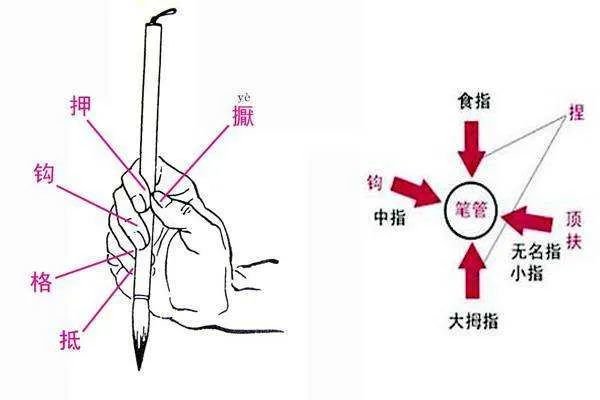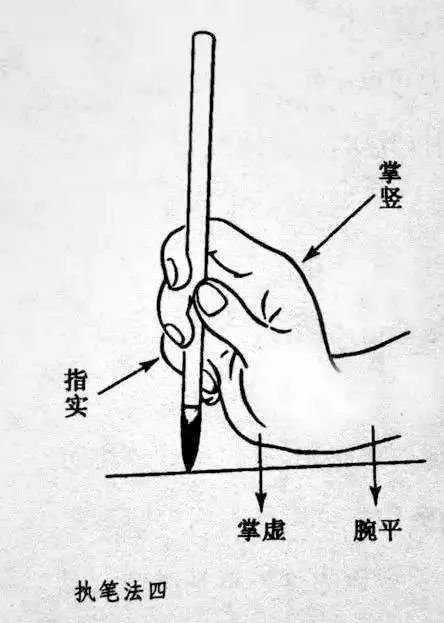five-finger writing method
The "Five Finger Writing Technique" is said to have been passed down by the "Two Kings". After Lu Xisheng obtained it in the Tang Dynasty, it was passed on to Qian Ruoshui in the Song Dynasty before it was made public.

The key points of the five-finger writing technique are: fingers are solid, palms are empty, palms are erect, wrists are flat, and the tube is straight.
Fingering means that the fingers should be strong when holding the pen, with the four outer fingers close to each other, the joints facing outward, and the fingers should be dense but not loose. Special attention should be paid to making the middle joint of the inner thumb bulge outward, making the tiger's mouth round like a stirrup. In this way, the five fingers work together to hold the pen firmly and powerfully, and it also helps to move the pen and make it tight and tight. If it's too tight, it won't work well; if it's too loose, it won't work well. Only by pointing to the truth can we achieve "no wasted hair, no spilled ink, focus on the heart, and stable writing."

Palm deficiency means that the palm should be empty when writing, and the fingers should not be bent into the palm. Neither the ring finger nor the little finger should touch the palm, as if holding an egg in the palm of the hand. The gap between your thumb and index finger should be wider. In this way, the writing can be steady and flexible, and it is easy to write strong and beautiful words.
Palm erect means that the palm of the hand should be erect when holding the pen. Only when the palm is upright can it be straight, and when it is straight can the front be straight. If the front is straight, it will have full strength and smooth movement in all directions.
Wrist flat means that the wrist and the tabletop should be parallel. Kang Youwei said, "If you want to use your body's strength, you must level your wrists and erect your front." Because the straight tube means the front is straight, which is closely related to the movement of the wrist and the erect palm. The palm is vertical, the wrist is flat, the tube is straight and the front is straight. In addition, the pen is used with the elbow hanging, which is both flexible and powerful.
The tube should be straight. When writing, try to keep the pen tube vertical on the paper, so that the strokes can be easily kept in the center. However, in the specific process of pen movement, the pen barrel sometimes has to pitch and tilt. What is important is that it is tilted but straight, and the center of gravity is stable.

writing position
The position of the pen is related to the size of the words being written. Generally speaking, the larger the word, the wider the pen needs to be swayed, and the higher the pen should be. Generally speaking, for characters of the same size, the writing position of running script is higher than that of regular script, and the writing position of cursive script is higher than that of running script. Just like holding chopsticks, the higher you hold the chopsticks, the wider the swing range; but it is also harder to control. So you need to decide where to hold the pen based on the font and word size.
When the writing position is low, the wrist can rest on the paper; when the writing position is slightly high, the wrist should rest on the back of the left hand; when the writing position is high, the wrist should leave the table and the elbow supports the edge of the table to write; if the writing position is higher, the wrist should be hanging while writing. (usually with standing posture). 1.4 When writing, focus on using wrist strength

If you think of your hand as a lever, the farther the fulcrum is from the pen, the more obvious the force effect will be; the closer the fulcrum is to the pen, the easier it will be to control. Therefore, when writing words of one to two inches (about 3-175px), you mainly use your wrist to exert force, and your fingers assist to control the fine movements of the pen. If it is more than two inches (more than 175px), you need to use arm strength on this basis.
Whether you can consciously use your wrist to exert force to complete the writing process has almost become a criterion for entry into calligraphy. If the wrist strength is strong, the strokes will be strong and powerful; if the wrist strength is insufficient, the strokes will be weak.








